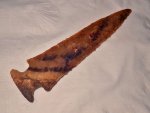What? These 2 rocks came from a spring on our farm. I think maybe petrified wood, but really don't know. The lines show like growth rings and the center maybe a pith. Also the larger has an outside layer like a cambrian layer. Your thoughts, please. Thanks
Welcome Guest!
You are using an out of date browser. It may not display this or other websites correctly.
You should upgrade or use an alternative browser.
You should upgrade or use an alternative browser.
Question for geologist; rock hounds
- Thread starter Jimmypop
- Start date
Looks more like a busted chert nodule, many types of chert have concentric rings like that. Given the amounts of points you find there, I'd guess it was stashed there by someone a few thousand years ago. Water-treatment can make chert easier to knap, and protect it from freezing.
Artfuldodger
Senior Member
Interesting, I'm not familiar with chert nodules. I did find a link to some nodules in a larger rock.
I would agree that it does look like wood as well.
I did notice that a lot of the pictures of chert nodules look like they have an outer layer different form the inside, even if not containing a lot of concentric rings.
http://skywalker.cochise.edu/wellerr/rocks/sdrx/chert3.htm
I would agree that it does look like wood as well.
I did notice that a lot of the pictures of chert nodules look like they have an outer layer different form the inside, even if not containing a lot of concentric rings.
http://skywalker.cochise.edu/wellerr/rocks/sdrx/chert3.htm
Buffalo River chert out of western Tennessee has rings like that. Purty stuff too.
Artfuldodger
Senior Member
I wonder if the nodules were traded from that area in Tennessee or found locally?
Did they trade nodules and pieces or already knapped arrowheads or both?
In other words, did they trade raw materials like chert and flint? I would think they did.
Did they trade nodules and pieces or already knapped arrowheads or both?
In other words, did they trade raw materials like chert and flint? I would think they did.
Last edited:
I wonder if the nodules were traded from that area in Tennessee or found locally?
Did they trade nodules and pieces or already knapped arrowheads or both?
In other words, did they trade raw materials like chert and flint? I would think they did.
Yes, stone, shell, and other "commodities of the time" were valuable trade items, and were moved over some really long distances. Obsidian from the Yellowstone area has been found in Ohio, Dover chert out of western Tennessee has been found in a literal campsite here in north Lee County, Ridge and Valley chert from north Georgia found in Decatur and Seminole Counties. Those are just a few examples.
Nic, I know of one obsidian point that came from an archaeological dig of a Mississippian mound in central NC. I have also seen a collection of Flint Ridge microblades that came from the area where Tellico Lake in TN is now.
They have found a lot of Great Lakes copper and Hopewellian pottery in the mounds here in western NC, and western NC sheet mica in Hopewellian mounds in northern Ohio and the surrounding areas.
They have found a lot of Great Lakes copper and Hopewellian pottery in the mounds here in western NC, and western NC sheet mica in Hopewellian mounds in northern Ohio and the surrounding areas.
I'm afraid my ignorance is showing through .....again. Let me start over. Stone age people made tools from petrified wood , palm wood , coral , flint , and chert , which started out as sea creatures , among other things , I suppose. My question is did some types of chert , like Buffalo River or others maybe , happen to have been a tree at some time in the past.....I wander.
No, it's just the way the nodules formed that causes the rings/bands in certain types of chert. Buffalo River, some KY/IN hornstone, Cobden, Alibates, Nethers Flint Ridge, and many, many other types of chert are banded like that. Chert is sedimentary rock.
Artfuldodger
Senior Member
I'm afraid my ignorance is showing through .....again. Let me start over. Stone age people made tools from petrified wood , palm wood , coral , flint , and chert , which started out as sea creatures , among other things , I suppose. My question is did some types of chert , like Buffalo River or others maybe , happen to have been a tree at some time in the past.....I wander.
Not my field either but I just googled petrified wood. I ran across "jasperized wood", "agatized wood", "Opalized wood", chalcedony in petrified wood, silica in petrified wood, etc.
I guess it's what defines the micro-structure of the chert, maybe?
I found this about Chert based on what it was formed from;
https://flexiblelearning.auckland.ac.nz/rocks_minerals/rocks/chert.html
I see people finding rocks and wondering if it's chert or wood.
There`s a variety of Coastal Plains chert in a couple of beds around here that is light tan colored with dark brown streaks across it. Looks just like you poured melted chocolate all over it. Beautiful stuff and you`ll occasionally find a point made from it. When I was knapping I loved to use it. Us locals call it "chocolate swirl".
I love that stuff too. Except for those chalky gray/white inclusions in it that a flake won't hardly run through. It gets some pretty red color when you heat it, too.There`s a variety of Coastal Plains chert in a couple of beds around here that is light tan colored with dark brown streaks across it. Looks just like you poured melted chocolate all over it. Beautiful stuff and you`ll occasionally find a point made from it. When I was knapping I loved to use it. Us locals call it "chocolate swirl".
Similar threads
- Replies
- 45
- Views
- 4K






